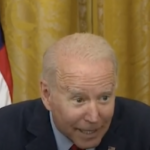President Obama’s Economic Legacy

As President Obama’s second term nears its end he has begun a media tour emphasizing what he claims are the positive aspects of his policies. The complicit media, of course, have long worked to inflate positive impressions of Obama’s legacy, and this latest set of interviews is no different.
“In two recent interviews, with The New York Times Magazine on his economic legacy and with The Atlantic on his foreign policy legacy, Mr. Obama expressed a common sentiment: He had achieved big things and avoided even bigger mistakes, and yet most people just shrug,” wrote Mark Landler for The New York Times on April 28.
Landler writes that this may be because Obama describes his successes as negatives, that “without the steps he took—or didn’t take…things would have turned out so much worse.”
Saying that things could have been worse without Obama’s policy interventions is an argument based on counterfactual reasoning, as if the President could somehow know the future that he avoided.
Yet President Obama and the mainstream media have fooled each other enough for each to think that the public’s problem is that President Obama simply hasn’t explained himself well enough.
“‘How people feel about the economy’…is influenced by ‘what they hear,’” President Obama told the Times in Andrew Ross Sorkin’s April 28 lengthy feature touting Obama’s economic legacy. President Obama then went on to blame Republicans for constantly telling their base that the nation’s economy has not improved.
But even the Times had to admit in that article that average family incomes are “$4,000 less than…when Bill Clinton left office,” and that the nation faces growing economic inequality.
“The private sector has added jobs for 73 consecutive months—some 14.4 million new jobs in all—the longest period of sustained job growth on record,” writes Sorkin for The Times. “Unemployment, which peaked at 10 percent the year Obama took office, the highest it had been since 1983, under Ronald Reagan, is now 5 percent, lower than when Reagan left office.”
As we have cited, the labor participation rate is currently under 63 percent—the same as it was in the 1970s. A low unemployment rate means little if Americans are no longer searching for work in the first place. And that is the main factor driving the unemployment rate down. The rate of unemployment alone does not tell the true story. Not even close.
As an example, last Friday the Bureau of Labor Statistics issued their monthly numbers, and said that 1.7 million people “wanted and were available for work, and had looked for a job sometime in the prior 12 months. They were not counted as unemployed because they had not searched for work in the 4 weeks preceding the survey.” The same press release said that there were six million people working as “involuntary part-time workers” because they couldn’t find full time jobs. Yet the administration, and their friends in the media, want you to look at that five percent unemployment figure and assume that the economy is doing well.
Roger Aronoff is the Editor of Accuracy in Media, and a member of the Citizens’ Commission on Benghazi. He can be contacted at roger.aronoff@aim.org. This column is excerpted from an article that he wrote for AIM.




